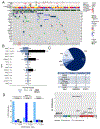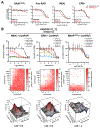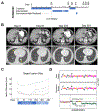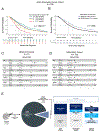Oncogenic Drivers and Therapeutic Vulnerabilities in KRAS Wild-Type Pancreatic Cancer
- PMID: 37463056
- PMCID: PMC10795103
- DOI: 10.1158/1078-0432.CCR-22-3930
Oncogenic Drivers and Therapeutic Vulnerabilities in KRAS Wild-Type Pancreatic Cancer
Abstract
Purpose: Approximately 8% to 10% of pancreatic ductal adenocarcinomas (PDAC) do not harbor mutations in KRAS. Understanding the unique molecular and clinical features of this subset of pancreatic cancer is important to guide patient stratification for clinical trials of molecularly targeted agents.
Experimental design: We analyzed a single-institution cohort of 795 exocrine pancreatic cancer cases (including 785 PDAC cases) with a targeted multigene sequencing panel and identified 73 patients (9.2%) with KRAS wild-type (WT) pancreatic cancer.
Results: Overall, 43.8% (32/73) of KRAS WT cases had evidence of an alternative driver of the MAPK pathway, including BRAF mutations and in-frame deletions and receptor tyrosine kinase fusions. Conversely, 56.2% of cases did not harbor a clear MAPK driver alteration, but 29.3% of these MAPK-negative KRAS WT cases (12/41) demonstrated activating alterations in other oncogenic drivers, such as GNAS, MYC, PIK3CA, and CTNNB1. We demonstrate potent efficacy of pan-RAF and MEK inhibition in patient-derived organoid models carrying BRAF in-frame deletions. Moreover, we demonstrate durable clinical benefit of targeted therapy in a patient harboring a KRAS WT tumor with a ROS1 fusion. Clinically, patients with KRAS WT tumors were significantly younger in age of onset (median age: 62.6 vs. 65.7 years; P = 0.037). SMAD4 mutations were associated with a particularly poor prognosis in KRAS WT cases.
Conclusions: This study defines the genomic underpinnings of KRAS WT pancreatic cancer and highlights potential therapeutic avenues for future investigation in molecularly directed clinical trials. See related commentary by Kato et al., p. 4527.
©2023 American Association for Cancer Research.
Figures





Comment in
-
KRAS Wild-Type Pancreatic Cancer: Decoding Genomics, Unlocking Therapeutic Potential.Clin Cancer Res. 2023 Nov 14;29(22):4527-4529. doi: 10.1158/1078-0432.CCR-23-2221. Clin Cancer Res. 2023. PMID: 37695631 Free PMC article.
References
-
- Siegel RL, Miller KD, Fuchs HE & Jemal A Cancer Statistics, 2021. Ca Cancer J Clin 71, 7–33 (2021). - PubMed
-
- Conroy T et al. FOLFIRINOX Versus Gemcitabine For Metastatic Pancreatic Cancer. New Engl J Medicine 364, 1817–25 (2011). - PubMed
-
- Bailey P et al. Genomic Analyses Identify Molecular Subtypes Of Pancreatic Cancer. Nature 531, 47–52 (2016). - PubMed
Publication types
MeSH terms
Substances
Grants and funding
LinkOut - more resources
Full Text Sources
Medical
Research Materials
Miscellaneous

